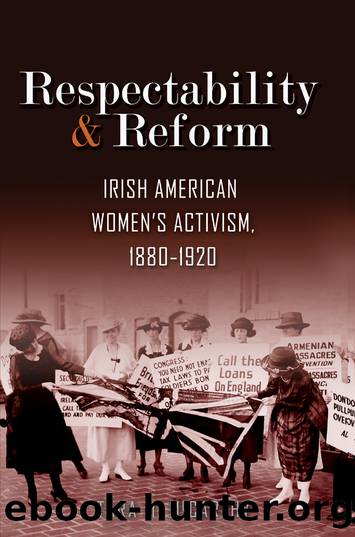Respectability and Reform by Tara M. McCarthy

Author:Tara M. McCarthy
Language: eng
Format: epub
ISBN: 9780815654360
Publisher: Syracuse University Press
Published: 2018-07-06T00:00:00+00:00
This chapter is derived, in part, from an article published in Womenâs History Review 23 (Apr. 2014), http://www.tandfonline.com/doi/abs/10.1080/09612025.2013.849143.
6
Twentieth-Century Connections
Suffrage Tactics, Trade Unionists, and the Lessons of Tammany Hall
In 1912 Literary Digest published a surprisingly sympathetic portrait of the Irish American suffragist Maud Malone. âMilitant Maud Malone,â as she was dubbed, did not throw rocks as suffragettes were doing in Britain, yet she had been âhowled at, booed at, insulted, ridiculed, [and] punched.â Arrested several times by then for interrupting political meetings, Malone helped lead the first wave of militant suffrage activity seen in the United States, beginning with the first open-air meetings in 1907. A pioneer in new suffrage techniques, Malone continued her militant activities with another militant Irish AmericanâLucy Burns, serving jail time with other members of the National Womanâs Party in 1917.1 Yet Malone is virtually unknown in histories of the movement today.
So who was Maud Malone? According to Literary Digest, she had âthe nose of a political economistâ and large and fearless âtrue Irish eyes with the glint of humor in them.â And according to the Womanâs Journal, she came âof fighting stock.â2 Malone, a second-generation Irish American, led the Harlem Equal Rights League in the early twentieth century and joined a group calling itself the American Suffragettes. However, in 1908 she broke with organized militants, accusing them of a desire to âattract a well-dressed crowd, not the rabble.â3 She also helped organize the first union of library employees, the Library Employeesâ Union of Greater New York, which affiliated with the American Federation of Labor in 1917.4 Although called the âLone Suffragetteâ in the press because she single-handedly interrupted meetings and staged protests, as a suffragist and an independent wage earner she also represented a larger trend: the revitalization of the suffrage movement in the early twentieth century through new campaigning techniques and the increased participation of working women.
Irish American women became more visible in the suffrage movement in the twentieth century for a number of reasons. Beginning in the late nineteenth century, a small group of female labor leaders began to show more interest in political rights for women, a trend that continued to grow in the early twentieth century. Furthermore, as the National American Woman Suffrage Association accelerated its efforts to get suffrage on state ballots, particularly in the East, they faced the key challenge of getting union votes, ethnic votes, and Catholic votes. Speakers who could appeal to these audiences were in demand in several states. The resurgence of Irish nationalism in the United States during the final Home Rule battle and the international crisis of the World War I era also led to greater connections between events in Ireland and American politics, and finally, as more Catholic women sought a role in social reform, they also began to accept the argument that votes for women meant protection of home and family, elevation of the downtrodden, and the preservation of morality. Therefore, Irish American women made three important contributions to the suffrage movement in
Download
This site does not store any files on its server. We only index and link to content provided by other sites. Please contact the content providers to delete copyright contents if any and email us, we'll remove relevant links or contents immediately.
A Cultural History of Work in the Age of Empire by Victoria E. Thompson (ed.)(289)
A Rome of One's Own by Emma Southon(274)
Executive Order No. 9066: The Terrible Injustice Of 1942 by Sollace Freeman(268)
The Evidence of Things Not Seen by James Baldwin(265)
The Explorers by Amanda Bellows(244)
Respectability and Reform by Tara M. McCarthy(239)
A Wider Type of Freedom: How Struggles for Racial Justice Liberate Everyone by Daniel Martinez HoSang(217)
The Grey Eagles of Chippewa Falls by John E. Kinville(189)
Liberty's Dawn: A People's History of the Industrial Revolution by Emma Griffin(188)
Rethinking White Societies in Southern Africa by Duncan Money(187)
Letters From London by Julian Barnes(182)
The Crosswinds of Freedom by James MacGregor Burns(179)
A Troublemaker May Surprise (The Troublemaker Series Book 2) by Genta Sebastian(171)
Evolution of Slavery Through the Ages: A Comprehensive World History of Slavery by PRESS VERITY(165)
Continental Strangers by Gemunden Gerd;(159)
A Teacher's Guide to Ladies of Liberty by Cokie Roberts Amy Jurskis(155)
The Slave Ship, Memory and the Origin of Modernity by Martyn Hudson(149)
Beware the Masher by Kerry Segrave(140)
Hunger Dark Pen by Dark Pen(137)
